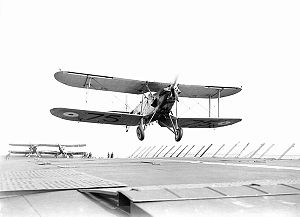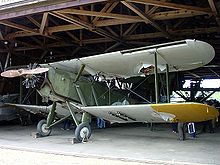Blackburn Ripon
| Ripon | |
|---|---|

| |
| Role | Torpedo bomber |
| Manufacturer | Blackburn Aircraft |
| First flight | 17 April 1926 |
| Retired | 1944, Finland |
| Primary users | Fleet Air Arm Finnish Air Force |
| Number built | 92 |
| Variants | Blackburn Baffin |
The Blackburn T.5 Ripon was a British carrier-based torpedo bomber and reconnaissance biplane which first flew in 1926. It was used by the Fleet Air Arm as a torpedo bomber from 1930 until 1935. Ripons were also sold to Finland, where they continued to be used in action in the Winter War and the Continuation War until 1944.
Development[]
The Blackburn Ripon was designed to replace the single-seat Dart torpedo bomber. In accordance with Air Ministry Specification 21/23, it was also required to be used for long-range reconnaissance, for which a two-man crew was demanded.[1] The first prototype flew on 17 April 1926 as a landplane, with the second prototype following on 26 August first flying as a seaplane.[1] Initial trials against its competitors, the Handley Page Harrow and the Avro Buffalo, showed that none of the competitors were adequate, so the Ripon was redesigned with an improved engine installation, an enlarged rudder and increased sweepback on the wings. Thus improved, the Ripon was declared the winner and ordered for service.[1]
Four prototypes and 90 production aircraft were manufactured by Blackburn for use by the Fleet Air Arm. The Baffin was a development of the Ripon, which replaced it in service with the Fleet Air Arm, with 68 Ripons converted to Baffins.
Service[]

The Ripon entered service with the Fleet Air Arm in 1929, six joining No 462 (Fleet Torpedo Bomber) Flight aboard HMS Furious in January of that year.[1] The Ripon was normally used as a carrier-based landplane by the Fleet Air Arm, and although capable of being converted to a seaplane, was rarely fitted with floats. The Ripon continued in service with Torpedo Bomber flights until 1933, when the Fleet Air Arm was reorganised into three larger squadrons, No. 810, No. 811 and No. 812.[1] The last Ripons were retired from service in January 1935 when 811 Naval Air Squadron re-equipped with Blackburn Baffins.
The Blackburn Ripon was also ordered for use by the Finnish Air Force, with one example for Finland being built by Blackburn, before 25 were produced under licence at the Finnish Aircraft Factory. These were powered with a number of different radial engines; the pattern aircraft had a 530 hp (400 kW) Bristol Jupiter VII, the next seven had 480 hp (360 kW) Gnome Rhone Jupiter VI, followed by eight with 535 hp (399 kW) Armstrong Siddeley Panther engines and the final ten with 580 hp (430 kW) Bristol Pegasus engines.[2] The Finnish Air Force used Ripons as reconnaissance aircraft against the Soviet Union in the Winter War and the Continuation War. After losing an aircraft to Soviet fighters in 1939, the Ripon was limited to night missions.[2] The last missions were flown in 1944.
One Ripon coded RI-140 was stored and has been reassembled and put on display in the Päijänne Tavastia Aviation Museum recently.[3] It is the only preserved example.
Variants[]
- Ripon I : Prototype. Two built.
- Ripon II : Initial production - 20 built (Many converted to Mk IICs).
- Ripon IIA : Metal-ribbed wings, with forward-firing machine gun added. - 40 produced.
- Ripon IIC : All-metal wings - 30 produced.
- Ripon III : Prototype with lengthened nose and new tail. One built.
- Ripon IIF : Two-seat reconnaissance, torpedo-bomber aircraft for the Finnish Air Force.
Operators[]
Specifications (Ripon IIC)[]
Data from The British Bomber[1]
General characteristics
- Crew: 3
- Length: 36 ft 9 in (11.20 m)
- Wingspan: 44 ft 10 in (13.67 m)
- Height: 12 ft 10 in (3.91 m)
- Wing area: 683 sq ft (63.5 m2)
- Empty weight: 4,132 lb (1,874 kg)
- Gross weight: 7,282 lb (3,303 kg)
- Powerplant: 1 × , XI or XIA W-12 water-cooled piston engine, 570 hp (430 kW)
- Propellers: 2-bladed fixed-pitch propeller
Performance
- Maximum speed: 96 kn (111 mph, 179 km/h) at sea level
- Range: 360 nmi (410 mi, 660 km)
- Service ceiling: 10,000 ft (3,000 m)
- Time to altitude: 6,500 ft (1,981 m) in 15 minutes 30 seconds
Armament
- Guns:
- 1 × fixed, forward firing .303 in (7.7 mm) Vickers machine gun (not Mk II) and 1 × .303 in (7.7 mm) Lewis gun in rear cockpit.
- Bombs:
- 1 × 18 in (457 mm) torpedo
- up to 3 × 530 lb (240 kg) or 6 × 230 lb (104 kg) bombs.
See also[]
Related development
Related lists
References[]
- ^ a b c d e f Francis K., Mason (1994). The British Bomber since 1914. Putnam Aeronautical Books. ISBN 0-85177-861-5.
- ^ a b Green, William (1967). Warplanes of the Second World War, Volume 7, Bombers and Reconnaissance Aircraft. London: Macdonald.
- ^ Kauppinen, Jukka O.; Riihelä, Hannu (25 May 2006). "Ripon esille Vesivehmaalla" (in Finnish). Virtuaalilentäjät – Virtual Pilots ry. Retrieved 22 March 2008.
External links[]
| Wikimedia Commons has media related to Blackburn Ripon. |
- Photos of Blackburn Ripon III in Flight
- 1920s British bomber aircraft
- Blackburn aircraft
- Carrier-based aircraft
- Single-engined tractor aircraft
- Biplanes
- Aircraft first flown in 1926
- World War II aircraft of Finland